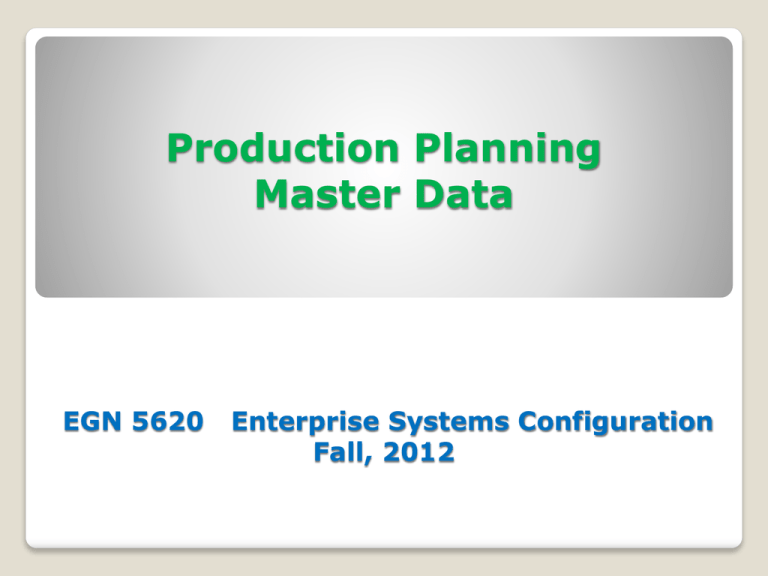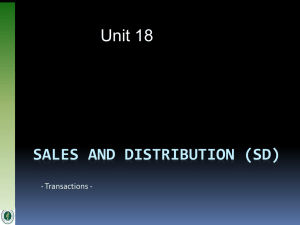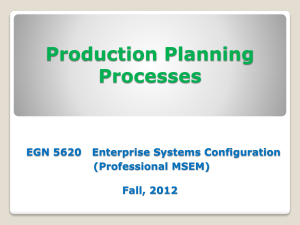
Production Planning
Master Data
EGN 5620
Enterprise Systems Configuration
Fall, 2012
Production and Planning
Master Data
SAP Implementation
EGN 5620
Enterprise Systems Configuration
Fall, 2012
Business Process Integration
FI MM PP SD
Rules
FI
MM
PP
SD
January 2008
© SAP AG - University Alliances and
The Rushmore Group, LLC 2008. All
rights reserved.
3
Business Process Integration
PP
Master Data
PP
January 2008
© SAP AG - University Alliances and
The Rushmore Group, LLC 2007. All
rights reserved.
4
Production Process (Make-to-Stock)
Capacity
Planning
Schedule
and Release
Shop Floor
Documents
Production
Proposal
(Planning/Other)
Production
Process
Order
Settlement
Goods
Issue
Completion
Confirmation
Goods
Receipt
Organization Data
Client
Company code
Plant
Storage location
Shipping point
Work Center
January 2008
© SAP AG - University Alliances and
The Rushmore Group, LLC 2007. All
rights reserved.
6
Work
Centers
Organization Structure
Credit Control
Area
Client (600)
Fiscal Year
Variant
Chart of
Accounts
Company
Controlling
Area
Code (C _ _ _)
Purchasing
Organization
Plant
Purchasing
Group
WC 10 WC 20
Sales
Organization
SL10 SL20
Shipping
Point
Distribution
Channel
Division
Sales Area
Organization Data - Work Center
It is a unique production or assembly area
It may include
◦
◦
◦
◦
◦
Equipment
Groups of equipment
Production lines
Employees
Groups of employees
Operations are carried out at work center
January 2008
© SAP AG - University Alliances and
The Rushmore Group, LLC 2007. All
rights reserved.
8
Organization Data
Plant-specific organizational units
◦
◦
◦
◦
◦
MRP controller
Production controller
Production scheduler
Planner group
Person responsible (financially)
Non-plant specific organizational units
◦ Capacity planner
January 2008
© SAP AG - University Alliances and
The Rushmore Group, LLC 2007. All
rights reserved.
9
BPI PP master data
PP
Master Data
PP
January 2008
© SAP AG - University Alliances and
The Rushmore Group, LLC 2007. All
rights reserved.
10
Master Data for Production Planning
Bill of Material Master Data
Work Center Master Data
Work Center Control Key
Product Routing
Material Types Allowed in Production
Controlling Activities For Production
Activity Prices
Materials
January 2008
© SAP AG - University Alliances and
The Rushmore Group, LLC 2007. All
rights reserved.
11
Bill of Materials
BOM is a hierarchical structure of the
materials needed to produce a finished
goods or semi-finished goods.
BOMs in SAP are defined as single-level,
but can be constructed multi-level by
nesting several single-level BOMs.
Nesting refers to a hierarchy in which a bill
of materials contains its own bills of
materials.
January 2008
© SAP AG - University Alliances and
The Rushmore Group, LLC 2007. All
rights reserved.
12
Bill of Material Master Data
Bill of Materials (BOM) are created as singlelevel or multi-level relationships between
one parent material and the sub-component
material
EPEN
Barrel
Cap
January 2008
Crown
Cartridge
Band
© SAP AG - University Alliances and The Rushmore Group, LLC
2007. All rights reserved.
Clip
13
Bill of Material Master Data
Variant Bill of Materials (BOM)
◦ Several products with a large proportion of
identical parts.
EPEN - Red
Red
Cartridge
Band
January 2008
EPEN - Black
Etc.
Black
Cartridge
Band
© SAP AG - University Alliances and The Rushmore Group, LLC
2007. All rights reserved.
Etc.
14
Bill of Material Master Data
Multiple versions of Bill Of Materials (BOM)
◦ One product produced from alternative
components or processes, where the
differences are small (usually the quantity of a
component).
◦ BOM 1 = lot size 1 - 100
◦ BOM 2 = lot size 101 – 999
EPEN - Black
Black
Cartridge
(Buy)
Band
January 2008
EPEN - Black
Etc.
Etc.
© SAP AG - University Alliances and The Rushmore Group, LLC
2007. All rights reserved.
Band
Black
Cartridge
(Make)
15
Bill of Material Master Data
Finished Good
Semi-finished
goods
Raw
Material
January 2008
Raw
Material
Raw
Material
Semi-finished
good
Raw
Material
© SAP AG - University Alliances and The Rushmore Group, LLC
2007. All rights reserved.
Raw
Material
16
Bill of Material Master Data
January 2008
© SAP AG - University Alliances and
The Rushmore Group, LLC 2007. All
rights reserved.
17
Bill of Material Master Data
BOM in SAP consists of a header section and an
item section.
Header section includes data that apply to entire
BOM, such as finished material number, plant,
usage, validity, status, and base quantity.
Usage identifies the purpose for which the BOM
can be used. For example, 1 is for production.
The BOM is valid from the date specified in the
header.
January 2008
© SAP AG - University Alliances and
The Rushmore Group, LLC 2007. All
rights reserved.
18
Bill of Materials Master Data
Items section identifies all materials needed to
make finished goods or semi-finished goods
identified in the header.
Item category determines how material is used
in the BOM.
Data for each item are:
◦ material number,
◦ description, quantity, and
◦ item category.
January 2008
© SAP AG - University Alliances and
The Rushmore Group, LLC 2007. All
rights reserved.
19
BOM MM Item Category
L: Stock item
N: Non-stock item
R: Variable –size item
T: Text item used to include notes and
comments within the BOM. Notes may
explain how to use the material or identify
any unusual assembly requirement.
D: Document item used to include
document such as engineering drawings,
assembly instructions, and photographs.
January 2008
© SAP AG - University Alliances and
The Rushmore Group, LLC 2007. All
rights reserved.
20
BOM MM Item Category
K: Class item used in variant BOMs to
identify a class or group of items. A
variant BOM is used to create multiple
versions.
M: Intra material, or phantom items used
as a logical grouped set of materials that
could collectively be considered as a
single material. Phantom material is not
an actual material and is mostly
temporarily used during production
planning.
January 2008
© SAP AG - University Alliances and
The Rushmore Group, LLC 2007. All
rights reserved.
21
Where to use BOM?
1.
MRP uses BOM to determine dependent
requirements
2.
Controlling uses BOM to calculate product costs
3.
Production uses BOM to issue the proper
quantities of components and raw materials to
the shop floor
January 2008
© SAP AG - University Alliances and
The Rushmore Group, LLC 2007. All
rights reserved.
22
Work Center
Work center is a location where value-added
work needed to produce a material is carried out.
A work center can be a machine, a group of
machines, an entire production line, a work area,
or a person or group of people who are
responsible for completing operations.
A work center is a resource that can be used for
a variety of purposes and for multiple processes.
January 2008
© SAP AG - University Alliances and
The Rushmore Group, LLC 2007. All
rights reserved.
23
Work Center
Work center used to define capacities
◦
◦
◦
◦
Labor
Machine
Output
Emissions
Capacities used in
◦ Capacity requirements planning (CRP)
Detailed scheduling
Costing
January 2008
© SAP AG - University Alliances and
The Rushmore Group, LLC 2007. All
rights reserved.
24
Work Center
Work Center is used:
◦ To be assigned as cost center
◦ To be allocated with Human Resources (HR)
Qualifications
Positions
People
January 2008
© SAP AG - University Alliances and
The Rushmore Group, LLC 2007. All
rights reserved.
25
Work Center
Work Centers have multiple views of:
◦
◦
◦
◦
◦
◦
Basic data
Default values
Capacity overview
Scheduling
Cost center assignment
Technical data
January 2008
© SAP AG - University Alliances and
The Rushmore Group, LLC 2007. All
rights reserved.
26
Work Center
Basic data section:
Name, and description of the work center
Person or group of people who are responsible for
completing operations
Task list: a list of operations that are required to
accomplish a task. Operations are the specific tasks that
must be completed, such as drilling, cutting, assembling.
In production, a task list takes the form of a product
routing or a master recipe.
Standard value key: used to assign standard or planned
values for operations, such as setup and execution times.
Companies use these values to calculate costs, execution
times, and capacity requirements.
January 2008
© SAP AG - University Alliances and
The Rushmore Group, LLC 2007. All
rights reserved.
27
Work Center
January 2008
© SAP AG - University Alliances and
The Rushmore Group, LLC 2007. All
rights reserved.
28
Work Center
Default Values: for operations performed at the
work center.
Control Keys: specify how an operation or a suboperation is scheduling, how costs will be
calculated, and how operations will confirmed
once they are completed in the work center.
Wage data: used by processes in human capital
management, such as payroll.
Standard value keys: identify the normal time
elements – the activities that consume time
associated with the work center. Typical time
elements are setup time, machine time, labor
time, and teardown time.
January 2008
© SAP AG - University Alliances and
The Rushmore Group, LLC 2007. All
rights reserved.
29
Work Center
January 2008
© SAP AG - University Alliances and
The Rushmore Group, LLC 2007. All
rights reserved.
30
Work Center
Available capacity defines how much work can be
performed at the work center.
◦ A work center can include more than one resource or
capacity, such as labor and machine.
Scheduling basis determines the specific capacity
to be utilized for production.
January 2008
© SAP AG - University Alliances and
The Rushmore Group, LLC 2007. All
rights reserved.
31
Work Center
January 2008
© SAP AG - University Alliances and
The Rushmore Group, LLC 2007. All
rights reserved.
32
Work Center
January 2008
© SAP AG - University Alliances and
The Rushmore Group, LLC 2007. All
rights reserved.
33
Work Center
A work center is associated with a cost center
which is a container for accumulation of costs.
Costs associated with operations completed in a
work center are calculated using formulas that
utilize the costs and standard values associated
with each activity type, for example,
setup,
labor, and
machine.
January 2008
© SAP AG - University Alliances and
The Rushmore Group, LLC 2007. All
rights reserved.
34
Work Center
January 2008
© SAP AG - University Alliances and
The Rushmore Group, LLC 2007. All
rights reserved.
35
Work Center Control Key
Scheduling
Determine capacity requirements
Inspection characteristics required
Confirmation required
Rework
Cost
Schedule external operations – std values
January 2008
© SAP AG - University Alliances and
The Rushmore Group, LLC 2007. All
rights reserved.
36
Product Routing
A list of tasks or operations that must be
performed to convert a material to a part,
component, or product.
Routing is a sequence of operations which
detail the manufacture of a product
Routings are used as a template for
production orders and run schedules as
well as a basis for product costing.
January 2008
© SAP AG - University Alliances and
The Rushmore Group, LLC 2007. All
rights reserved.
37
Routing
Routing are used to determine:
Operations
Work centers
Material components
Production resources and tools
Quality Checks
January 2008
© SAP AG - University Alliances and
The Rushmore Group, LLC 2007. All
rights reserved.
38
Routing
January 2008
© SAP AG - University Alliances and
The Rushmore Group, LLC 2007. All
rights reserved.
39
Routing
January 2008
© SAP AG - University Alliances and
The Rushmore Group, LLC 2007. All
rights reserved.
40
Routing
January 2008
© SAP AG - University Alliances and
The Rushmore Group, LLC 2007. All
rights reserved.
41
Routing Use
Routings will be used in
◦
◦
◦
◦
Scheduling (dates, times)
Costing
Capacity planning
Production orders
January 2008
© SAP AG - University Alliances and
The Rushmore Group, LLC 2007. All
rights reserved.
42
Routing
Standard
Sequence
Operation 10
Operation 20
Alternate
Sequence
Operation 10
Operation 20
Parallel
Sequence
Operation 10
Operation 20
Operation 25
Operation 25
Operation 30
Operation 30
Operation 30
Operation 40
January 2008
Operation 40
Operation 40
© SAP AG - University Alliances and The Rushmore Group, LLC
2007. All rights reserved.
43
Material Types Allowed in Production
Multiple material types may be used in a
routing/BOM
Raw materials
Semi-finished product
Trading goods are allowed but not standard
Text or Reference materials common
January 2008
© SAP AG - University Alliances and
The Rushmore Group, LLC 2007. All
rights reserved.
44
Display Routing List
A collective report displaying the available
routings and the material allocations to
operations
Four General Types
◦
◦
◦
◦
Operations Related
Component Related
Production Resource/Tool (PRT ) Related
General List (Operation Control Ticket)
January 2008
© SAP AG - University Alliances and
The Rushmore Group, LLC 2007. All
rights reserved.
45
Controlling Activities for Production
Used to perform internal cost allocation,
where activities by a cost center are
measured
◦ Labor time
◦ Machine hours
Output activities are valued
Allocation of an activity type is always
made with the allocation cost element
created in activity type planning
January 2008
© SAP AG - University Alliances and
The Rushmore Group, LLC 2007. All
rights reserved.
46
Activity Prices
Prices (costs) for planned activities
◦ Fixed or Variable
Labor = $$/hour
Machine = $/hour
Overhead = %
January 2008
© SAP AG - University Alliances and
The Rushmore Group, LLC 2007. All
rights reserved.
47
Product Group
Aggregate planning that group together
materials or other product groups
(Product Families)
◦ Manufacturing procedure
◦ Product design
◦ Market niche, etc.
Proportional Factors (Percentages for
components)
Product Groups
•
Multi-level or single-level
– A product group is multi-level if it contains
other product groups
– Lowest level in a product group hierarchy
always consists of materials.
– A product group is single-level if its members
are materials only
– A material or product group can be a member
of more than one owner product group
January 2008
© SAP AG - University Alliances and
The Rushmore Group, LLC 2007. All
rights reserved.
49
BPI PP Rules
PP
PP
January 2008
© SAP AG - University Alliances and
The Rushmore Group, LLC 2007. All
rights reserved.
50
MRP Control Parameters
Environment
◦ Number range
Master Data
◦ Materials Requirements Planning controllers
◦ Float times
Planned Orders
◦ Conversion order type
◦ Dependant requirement availability
January 2008
© SAP AG - University Alliances and
The Rushmore Group, LLC 2007. All
rights reserved.
51
MRP Control Parameters
Planning run
◦ Bill of Material (BOM) selection
◦ External procurement
◦ Planning horizon
Availability Check
◦ Material
◦ Production Resource/Tool (PRT )
◦ Capacity
Scheduling Control Parameters
January 2008
© SAP AG - University Alliances and
The Rushmore Group, LLC 2007. All
rights reserved.
52
General Planning Parameters
Order Type Control Parameters
◦ Types of routings,
◦ BOM’s per order type:
manually or automatically
◦ Availability checking
Create Confirmation Parameters
◦ Reservations
◦ Status Updates
Define Valuation of Goods Received
◦ Moving Average Price Control evaluation
January 2008
© SAP AG - University Alliances and
The Rushmore Group, LLC 2007. All
rights reserved.
53
MM Planning Parameters
Materials Requirements Planning views
◦ for materials
Work Scheduling views
◦ for manufactured products
January 2008
© SAP AG - University Alliances and
The Rushmore Group, LLC 2007. All
rights reserved.
54
Production and Planning
Master Data
PEN, Inc.
EGN 5620
Enterprise Systems Configuration
Fall, 2011
Pen Inc. Business Module II for
Selling Finished Goods by Production
Pre-Sales
Activity
Sales
Order
Delivery
Availability
Check
In
Inventory
NO
Purchase
Requisition
Accounts
Receivable
Inventory
Postings
General
Ledger
Accounts
Goods Issued
to Delivery
YES
Issue Goods
to Production
Order
NO
Billing
Plant or
Warehouse
Purchase
Order
Goods from
Production Order
Goods
Receipt
Invoice
Receipt
Accounts
Payable
Or
Planned
Order
Production
Order
Completion © SAP AG - University Alliances and
The Rushmore Group, LLC 2008. All
Confirmation
January 2008 rights reserved.
56
Activity Type/Price Planning
January 2008
© SAP AG - University Alliances and
The Rushmore Group, LLC 2007. All
rights reserved.
57
Production Group
January 2008
© SAP AG - University Alliances and
The Rushmore Group, LLC 2007. All
rights reserved.
58
PPP Orders
Planned Order (planning)
◦ A request created in the planning run for a
material in the future (converts to either a
production or purchase order)
Production Order (execution)
◦ A request or instruction internally to produce a
specific product at a specific time
Purchase Order (execution)
◦ A request or instruction to a vendor for a
material or service at a specific time
Exercises:
212.
213.
214.
215.
216.
217.
258.
265.
266.
267.
269.
270.
271.
272.
Create primary cost elements
Create secondary cost elements
Create cost element groups
Create statistical key figure
Create controlling document number ranges
Define controlling settlement document number ranges
Create vender master records centrally
Create bill of materials
Create person responsible for work center
Create work center location
Create capacity
Create activity type labor
Set activity prices
Create work center for production
Exercises:
273. Create finished products routing
274. Display routing list
275A. Create material master for production group
275B. Assign numbers for product group





